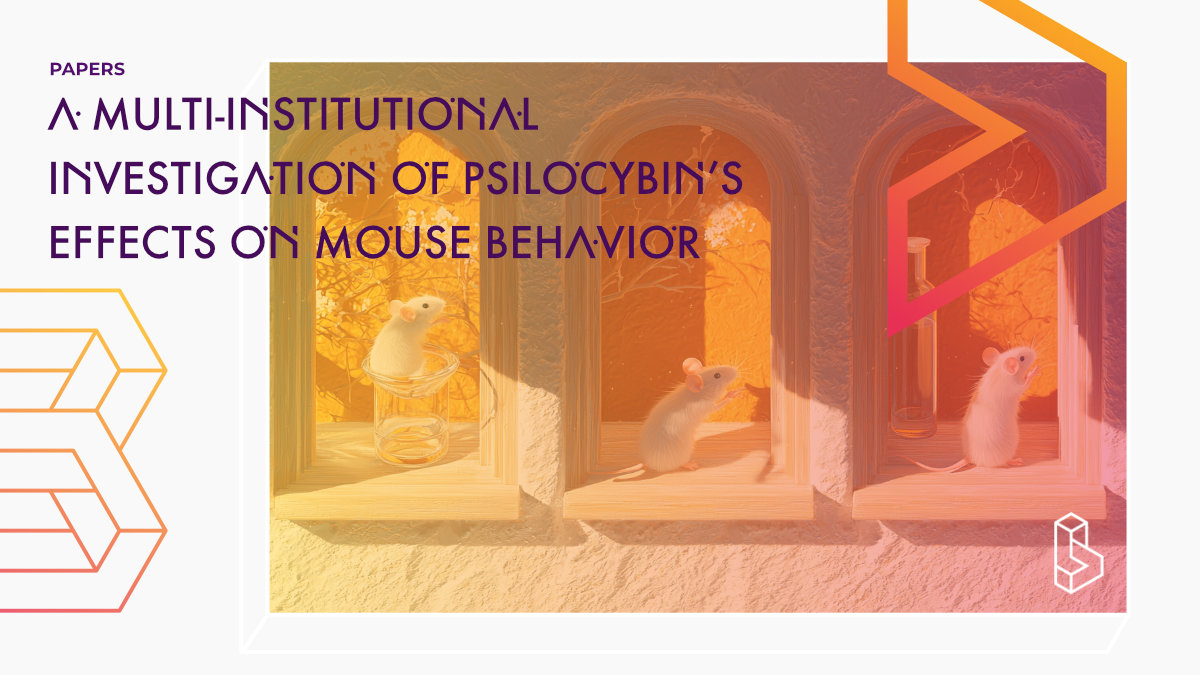This pre-print multi-laboratory mouse study (n=~200 mice across five sites) demonstrates that psilocybin (2mg/kg) produces robust acute effects in mice including increased anxiety-related behaviours and decreased fear expression. However, it fails to show consistent persistent therapeutic effects 24 hours after administration, suggesting previous claims about psilocybin’s lasting benefits may have been overstated.
Abstract of A multi-institutional investigation of psilocybin’s effects on mouse behavior
“Studies reporting novel therapeutic effects of psychedelic drugs are rapidly emerging. However, the reproducibility and reliability of these findings could remain uncertain for years. Here, we implemented a multi-institutional collaborative approach to define the robust and replicable effects of the psychedelic drug psilocybin on mouse behavior. Five laboratories performed the same experiments to test the acute and persistent effects of psilocybin (2 mg/kg, IP) on various behaviors that psychedelics have been proposed to affect, including anxiety-related approach-avoidance, exploration, sociability, depression-related behaviors, fear extinction, and social reward learning. Through this coordinated approach, we found that psilocybin had several robust and replicable acute effects on mouse behavior, including increased anxiety- and avoidance-related behaviors and decreased fear expression. Surprisingly, however, we found that psilocybin did not have replicable effects 24 hours post psilocybin administration on reducing anxiety- and depression-like behaviors or facilitating fear extinction learning. Additionally, we were unable to observe psilocybin-induced alterations in social preference or social reward learning. Overall, our comprehensive characterization of psilocybin’s acute and persistent behavioral effects using ∼200 total male and female mice per experiment spread across five independent labs demonstrates with unique certainty several acute drug effects and suggests that psilocybin’s persistent effects in mice may be more modest and inconsistent than previously suggested. We believe this unusual multi-laboratory, highly coordinated research effort serves as a model for facilitating the generation of replicable results and consequently will reduce efforts based on unreliable and spurious results.“
Authors: Odilia D. Lu, Katrina White, Kendall Raymond, Christine Liu, Alexandra S. Klein, Nathaniel Green, Sam Vaillancourt, Austin Gallagher, Lena Shindy, Alyssa Li, Kira Wallquist, Ruoxian Li, Mila Zou, Austen B. Casey, Lindsay P. Cameron, Matthew B. Pomrenze, Vikaas Sohal, Mazen A. Kheirbek, Andrea M. Gomez, Stephan Lammel, Boris D. Heifets & Robert Malenka
Summary of A multi-institutional investigation of psilocybin’s effects on mouse behavior
In recent years, there has been renewed scientific interest in studying psychedelic compounds, with numerous studies showing that single or limited doses of substances like psilocybin, MDMA, LSD, and ibogaine/iboga may have rapid and lasting therapeutic effects for various neuropsychiatric conditions. These preliminary clinical findings have generated considerable excitement in both scientific and public spheres, as they suggest psychedelics could dramatically transform psychiatric treatment. This potential is further evidenced by the fact that MDMA, LSD, and psilocybin have received Breakthrough Therapy designation from the FDA.
However, Lu and colleagues note that advancing our understanding of psychedelics’ mechanisms and therapeutic applications requires that findings be both robust (showing large effect sizes) and replicable (reproducible across different research groups). The field currently struggles with both aspects. For example, psilocybin, which has received significant attention for depression treatment, failed to demonstrate superior efficacy compared to escitalopram in clinical trials. Some researchers have questioned whether its effects exceed placebo responses. Furthermore, inconsistent findings have emerged regarding both psilocybin’s behavioural outcomes and mechanisms of action in mouse studies.
Given these challenges, the researchers argue that a new research approach is necessary. Current academic research norms, where scientists independently investigate similar questions, can lead to differing results due to slight methodological variations. Without highly consistent methodology and extensive communication between investigators, discrepancies in psilocybin’s effects across independent studies may become increasingly difficult to resolve.
Methods
Study Design
Find this paper
A multi-institutional investigation of psilocybin's effects on mouse behavior
https://doi.org/10.1101/2025.04.08.647810
Open Access | Google Scholar | Backup | 🕊
Cite this paper (APA)
Lu, O. D., White, K., Raymond, K., Liu, C., Klein, A. S., Green, N., ... & Malenka, R. C. (2025). A multi-institutional investigation of psilocybin's effects on mouse behavior. bioRxiv, 2025-04.
Study details
Compounds studied
Psilocybin
Topics studied
Neuroscience
Depression
Anxiety
Study characteristics
Animal Study
Bio/Neuro
Participants
200
Rodents

